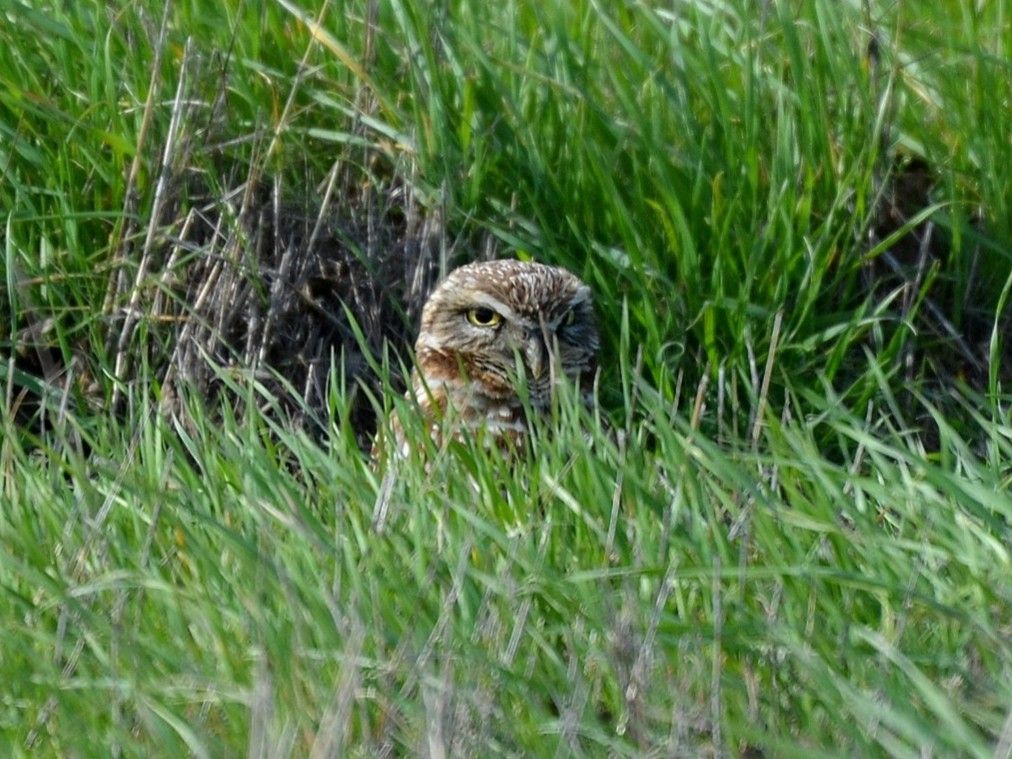Science Corner - Burrowing Owls

Do you remember the Haunted Forest in the Wizard of Oz? Most of us probably envision owls as those shadowy birds with the glowing eyes skulking at Dorothy and the gang from the dark tree canopy. True, most owls are nighttime creatures, and they do have large round eyes, but they certainly don’t glow like a red-hot cigarette lighter in a 1985 Oldsmobile. And yes, most species of common owls do roost in trees but, did you know that we have a very special little owl in our region that is active during the day as well as the night and nests and roots in underground burrows?! I realize that the name kind of gives it away but if you guessed Burrowing Owls, pat yourself on the back!
Burrowing Owls (Athene cunicularia) are a small species of owl that belong to the family Strigidae, the same family that includes other owls in our region including Great-horned Owls, Screech Owls and the eared owls. The name Athene comes from the Greek goddess of wisdom and cunicularia translates from Latin to mean miner or burrower - quite literally meaning “wise burrower”.
Burrowing Owls are fairly social and although they usually only have one mate at a time, they tend to nest and live in loose colonies. Males and females look alike however males are often lighter in color from sun bleaching as they spend more time outdoors while the females remain underground with the young. Both sexes average between seven and 11 inches long with wingspans of about 20-24 inches. They weigh five to eight ounces with females weighing slightly more than males. Both males and females lack ear tufts and have a flattened facial disk with prominent white eyebrows. Their large eyes are bright yellow, and their beaks are dark yellow to gray. Their heads, backs and wings are sandy brown with white mottling, and their abdomens and chests are a buffy brownish-gray with white barring. Juveniles look similar but lack the white mottling or barring. If you ask me, one of their most endearing physical traits are their long legs. Burrowing Owls prefer open areas and their lengthy legs allow them to perch on the ground and still keep watch over their surroundings. When disturbed, or even if they think they might be disturbed, agitated owls will bob up and down while chirping and giving whatever they’re perceiving as a threat the death stare. If that isn’t enough to intimidate the presumed threat, the owl will simply fly off. Another fascinating behavior is Burrowing Owls’ love of decor. They will collect things they find interesting and decorate the entrance of their burrow. These items often include flower petals, shiny things such as bottle caps, bits of beetle exoskeleton, and small rocks. Sometimes Burrowing Owls will collect scat from larger animals which in turn attracts dung beetles that become a “door dash” snack delivery for the owls.
Being active during both the day and night hours helps the owls to secure different food sources; prey species include insects, amphibians and small lizards during the day and small mammals at night.
There are several subspecies of Burrowing owls but the genus as a whole has historically occurred from southwestern Canada, the western United States (minus the humid Pacific Northwest) into Mexico and east into Florida, in Central America, some Caribbean Islands and in most of South America. Most populations of Burrowing Owls do not migrate but those that occupy the northern end of their range may migrate seasonally to avoid the cold winter months (I would too!). Their habitat preferences include open or grazed areas with shorter vegetation such as dry pastures, prairies, open grasslands, savannas with an established burrowing mammal population to provide underground nesting locations for the owls. Burrowing Owls are extremely adaptable and have also occupied urban areas such as airports, golf courses, grassy areas in highway interchanges, parks, schools, parking lots and even landfills and other other relatively undisturbed urban and suburban areas. Most individuals do not excavate their own burrows but rather take over abandoned mammal burrows including those dug by ground squirrels, prairie dogs and badgers. Some populations and subspecies will dig their own burrows or enhance those made by other species if the soil is not rocky or compact. Burrowing Owls have been documented utilizing man-made burrows as well.
The subspecies found in our region is the Western Burrowing Owl (Athene cunicularia hypugaea). Once widely disturbed across California, habitat loss as a result of urbanization, ground squirrel population decline, pesticide use, predation from coyotes, foxes, badgers, feral cats and changes in land use practices have resulted in drastic population declines since the 1980’s. Several attempts have been made to give the Western Burrowing Owl protection as a special-status species, however, as of yet it has not been afforded any official lasting protection.
If you’ve had the pleasure of observing burrowing owls you know exactly how charismatic they can be. If you haven’t seen them do keep your eyes open for them, you’ll be glad you did!
-Kristie Ehrhardt (kehrhardt@tuleyome.org)
Tuleyome Land Conservation Program Manager
RECENT ARTICLES






